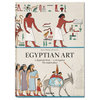
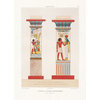
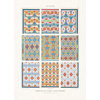
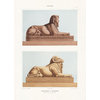
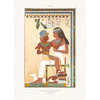
Item 1 of 5







Item 1 of 5


- Product Description
- Product Specifications
- Shipping and Returns
Symmetry and opulence
Exploring the Valley of the Kings
A lifelong devotee of ancient Egyptian and Oriental culture, the French author, artist, and scholar Achille-Constant-Théodore-Émile Prisse d’Avennes (1807–1879) is famed as one of the most influential Egyptologists, long before the discipline was even properly established.
Prisse first embarked on his explorations in 1836, documenting sites throughout the Nile Valley, often under his Egyptian pseudonym, Edris Effendi. Prisse’s first publication of notes, drawings and squeezes (a kind of frottage) came in the form of Les Monuments égyptiens, a modest collection of 51 plates, but one met with considerable acclaim in both popular and intellectual circles.
Encouraged by his success, Prisse returned to Egypt in the late 1850s to expand his work. His subsequent, vast oeuvres, L’Histoire de l’art égyptien and L’Art arabe, offer a truly complete survey of Egyptian art. The albums cover architecture, drawing, sculpture, painting and industrial or minor arts, with sections, plans, architectural details and surface decoration all documented with utmost sensitivity and accuracy. Even when compared to the products of the great state-sponsored expeditions to Egypt of this period, Prisse’s compendium remains the largest, singlehanded illustrated record of Egyptian art in existence.
This publication brings together for the first time the complete collection of Prisse’s unsurpassed illustrations in a visual and archaeological feast of symmetry and complexity, mystery and opulence.
Exploring the Valley of the Kings
A lifelong devotee of ancient Egyptian and Oriental culture, the French author, artist, and scholar Achille-Constant-Théodore-Émile Prisse d’Avennes (1807–1879) is famed as one of the most influential Egyptologists, long before the discipline was even properly established.
Prisse first embarked on his explorations in 1836, documenting sites throughout the Nile Valley, often under his Egyptian pseudonym, Edris Effendi. Prisse’s first publication of notes, drawings and squeezes (a kind of frottage) came in the form of Les Monuments égyptiens, a modest collection of 51 plates, but one met with considerable acclaim in both popular and intellectual circles.
Encouraged by his success, Prisse returned to Egypt in the late 1850s to expand his work. His subsequent, vast oeuvres, L’Histoire de l’art égyptien and L’Art arabe, offer a truly complete survey of Egyptian art. The albums cover architecture, drawing, sculpture, painting and industrial or minor arts, with sections, plans, architectural details and surface decoration all documented with utmost sensitivity and accuracy. Even when compared to the products of the great state-sponsored expeditions to Egypt of this period, Prisse’s compendium remains the largest, singlehanded illustrated record of Egyptian art in existence.
This publication brings together for the first time the complete collection of Prisse’s unsurpassed illustrations in a visual and archaeological feast of symmetry and complexity, mystery and opulence.
The author:
Salima Ikram is a professor of Egyptology at the American University in Cairo and has participated in many Egyptian archaeological projects. After double majoring in history as well as Classical and Near Eastern Archaeology at Bryn Mawr College in the United States, she received her MPhil and PhD in Egyptian Archaeology from Cambridge University (UK). She has directed the Animal Mummy Project, co-directed the Predynastic Gallery Project and is co-director of the North Kharga Oasis Survey. As an acknowledged expert she has lectured on her work all over the world. Salima Ikram is also the author of several books on Egyptian Archaeology, publishes in both scholarly and popular journals, and is a contributor to various magazines.Émile Prisse d'Avennes. Egyptian Art
Symmetry and opulence
Exploring the Valley of the Kings
A lifelong devotee of ancient Egyptian and Oriental culture, the French author, artist, and scholar Achille-Constant-Théodore-Émile Prisse d’Avennes (1807–1879) is famed as one of the most influential Egyptologists, long before the discipline was even properly established.
Prisse first embarked on his explorations in 1836, documenting sites throughout the Nile Valley, often under his Egyptian pseudonym, Edris Effendi. Prisse’s first publication of notes, drawings and squeezes (a kind of frottage) came in the form of Les Monuments égyptiens, a modest collection of 51 plates, but one met with considerable acclaim in both popular and intellectual circles.
Encouraged by his success, Prisse returned to Egypt in the late 1850s to expand his work. His subsequent, vast oeuvres, L’Histoire de l’art égyptien and L’Art arabe, offer a truly complete survey of Egyptian art. The albums cover architecture, drawing, sculpture, painting and industrial or minor arts, with sections, plans, architectural details and surface decoration all documented with utmost sensitivity and accuracy. Even when compared to the products of the great state-sponsored expeditions to Egypt of this period, Prisse’s compendium remains the largest, singlehanded illustrated record of Egyptian art in existence.
This publication brings together for the first time the complete collection of Prisse’s unsurpassed illustrations in a visual and archaeological feast of symmetry and complexity, mystery and opulence.
Exploring the Valley of the Kings
A lifelong devotee of ancient Egyptian and Oriental culture, the French author, artist, and scholar Achille-Constant-Théodore-Émile Prisse d’Avennes (1807–1879) is famed as one of the most influential Egyptologists, long before the discipline was even properly established.
Prisse first embarked on his explorations in 1836, documenting sites throughout the Nile Valley, often under his Egyptian pseudonym, Edris Effendi. Prisse’s first publication of notes, drawings and squeezes (a kind of frottage) came in the form of Les Monuments égyptiens, a modest collection of 51 plates, but one met with considerable acclaim in both popular and intellectual circles.
Encouraged by his success, Prisse returned to Egypt in the late 1850s to expand his work. His subsequent, vast oeuvres, L’Histoire de l’art égyptien and L’Art arabe, offer a truly complete survey of Egyptian art. The albums cover architecture, drawing, sculpture, painting and industrial or minor arts, with sections, plans, architectural details and surface decoration all documented with utmost sensitivity and accuracy. Even when compared to the products of the great state-sponsored expeditions to Egypt of this period, Prisse’s compendium remains the largest, singlehanded illustrated record of Egyptian art in existence.
This publication brings together for the first time the complete collection of Prisse’s unsurpassed illustrations in a visual and archaeological feast of symmetry and complexity, mystery and opulence.
The author:
Salima Ikram is a professor of Egyptology at the American University in Cairo and has participated in many Egyptian archaeological projects. After double majoring in history as well as Classical and Near Eastern Archaeology at Bryn Mawr College in the United States, she received her MPhil and PhD in Egyptian Archaeology from Cambridge University (UK). She has directed the Animal Mummy Project, co-directed the Predynastic Gallery Project and is co-director of the North Kharga Oasis Survey. As an acknowledged expert she has lectured on her work all over the world. Salima Ikram is also the author of several books on Egyptian Archaeology, publishes in both scholarly and popular journals, and is a contributor to various magazines.- Product ID
- 23186558
- Sold By
- hproduct
- Size
- W 12.4" / H 17.1"
- Materials
- Hardcover
- Category
- Books
- Style
- Traditional
- Product Description
- Product Specifications
- Shipping and Returns
Symmetry and opulence
Exploring the Valley of the Kings
A lifelong devotee of ancient Egyptian and Oriental culture, the French author, artist, and scholar Achille-Constant-Théodore-Émile Prisse d’Avennes (1807–1879) is famed as one of the most influential Egyptologists, long before the discipline was even properly established.
Prisse first embarked on his explorations in 1836, documenting sites throughout the Nile Valley, often under his Egyptian pseudonym, Edris Effendi. Prisse’s first publication of notes, drawings and squeezes (a kind of frottage) came in the form of Les Monuments égyptiens, a modest collection of 51 plates, but one met with considerable acclaim in both popular and intellectual circles.
Encouraged by his success, Prisse returned to Egypt in the late 1850s to expand his work. His subsequent, vast oeuvres, L’Histoire de l’art égyptien and L’Art arabe, offer a truly complete survey of Egyptian art. The albums cover architecture, drawing, sculpture, painting and industrial or minor arts, with sections, plans, architectural details and surface decoration all documented with utmost sensitivity and accuracy. Even when compared to the products of the great state-sponsored expeditions to Egypt of this period, Prisse’s compendium remains the largest, singlehanded illustrated record of Egyptian art in existence.
This publication brings together for the first time the complete collection of Prisse’s unsurpassed illustrations in a visual and archaeological feast of symmetry and complexity, mystery and opulence.
Exploring the Valley of the Kings
A lifelong devotee of ancient Egyptian and Oriental culture, the French author, artist, and scholar Achille-Constant-Théodore-Émile Prisse d’Avennes (1807–1879) is famed as one of the most influential Egyptologists, long before the discipline was even properly established.
Prisse first embarked on his explorations in 1836, documenting sites throughout the Nile Valley, often under his Egyptian pseudonym, Edris Effendi. Prisse’s first publication of notes, drawings and squeezes (a kind of frottage) came in the form of Les Monuments égyptiens, a modest collection of 51 plates, but one met with considerable acclaim in both popular and intellectual circles.
Encouraged by his success, Prisse returned to Egypt in the late 1850s to expand his work. His subsequent, vast oeuvres, L’Histoire de l’art égyptien and L’Art arabe, offer a truly complete survey of Egyptian art. The albums cover architecture, drawing, sculpture, painting and industrial or minor arts, with sections, plans, architectural details and surface decoration all documented with utmost sensitivity and accuracy. Even when compared to the products of the great state-sponsored expeditions to Egypt of this period, Prisse’s compendium remains the largest, singlehanded illustrated record of Egyptian art in existence.
This publication brings together for the first time the complete collection of Prisse’s unsurpassed illustrations in a visual and archaeological feast of symmetry and complexity, mystery and opulence.
The author:
Salima Ikram is a professor of Egyptology at the American University in Cairo and has participated in many Egyptian archaeological projects. After double majoring in history as well as Classical and Near Eastern Archaeology at Bryn Mawr College in the United States, she received her MPhil and PhD in Egyptian Archaeology from Cambridge University (UK). She has directed the Animal Mummy Project, co-directed the Predynastic Gallery Project and is co-director of the North Kharga Oasis Survey. As an acknowledged expert she has lectured on her work all over the world. Salima Ikram is also the author of several books on Egyptian Archaeology, publishes in both scholarly and popular journals, and is a contributor to various magazines.At Houzz we want you to shop for Émile Prisse d'Avennes. Egyptian Art with confidence. You can read real customer reviews for this or any other product and even ask questions and get answers from us or straight from the brand. When you buy Émile Prisse d'Avennes. Egyptian Art or any product product online from us, you become part of the Houzz family and can expect exceptional customer service every step of the way. If you have questions about or any other product for sale, our customer service team is eager to help.
Browse over 25 million home design photos on Houzz






